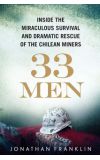
31 Mar 2011 05:22:48
More than a billion viewers followed blanket news coverage of the drama, which offered angles for every taste, from engineering exploits rivaling the Apollo 13 rescue to the raw emotions of reality TV.
And yet it was clear for those of us covering the story that it would take well-written books based on the miners' recollections to provide details about how they survived — particularly during the first 17 days, when few believed they could be found in time.
"How did a ragtag band of desperate miners and their families become a showcase of tenderness and emotional intelligence?" asks Jonathan Franklin, author of "33 Men." "They were hardened men, survivors who labored in anonymous corners of a dark cave where few other humans could last a single shift. ... Yet they became an example to the world, a symbol of survival. A brief reminder that like evil, good exists. And a reminder that in an ever more connected world, a single event has the power to unite us."
His book recreates hidden scenes from those first days, including the miners' private conversations and thoughts.
"It is terrifying, like the rocks are screaming in pain," he quotes miner Jose Ojeda, in a passage that describes how they battled through dust and darkness in a frustrated escape attempt. "We tried to advance, but we couldn't; a wall of rock blocked us."
Franklin says he always based quoted conversations on the recollection of at least one of the participants. Some may argue with this technique, but it provides a gripping read. And he provides enough supporting detail to argue for its credibility.
Some of his assertions have been denied by some of the miners, such as references to family members sneaking marijuana and other contraband down to their men. He also dwells unnecessarily on tabloid questions about the miners' sex drives, and some Chilean readers may be offended by his assertion that many of the men who emerged as heroes had suffered from alcoholism, drug abuse and broken families.
The book also includes some delightful surprises — like how some miners went down to the very bottom of the mine, where water used in the drilling had been collecting, and enjoyed what had become an underground swimming pool.
And Franklin writes that President Sebastian Pinera's government did a remarkable job of keeping the men safe, bringing the world's best experts and technology into a rescue operation that cost roughly $600,000 per man.
A key chapter describes how Pedro Gallo, a local gadget-hound who worked into the rescue operation after designing a tiny phone that provided the first audio link to the trapped men, kept the world from knowing about a potentially devastating rock slide that cut off the live television feed of the bottom of the escape shaft halfway through the rescue.
Franklin's description of how Gallo switched to a previously taped image while miner Pedro Cortes raced through the collapsing shaft to replace a severed cable was denied by Reinaldo Sepulveda, who ran the live broadcast. With seven other camera angles to choose from, he told The Associated Press that there was no need to show a previously taped image while Gallo fixed his handmade camera link. But reporters watching the drama unfold remember a period when the space where miners had been waiting to climb into the capsule appeared to be inexplicably empty.
When drillers finally opened the escape shaft, Franklin writes, cooler air caused the rock walls to contract, destabilizing the entire mine.

